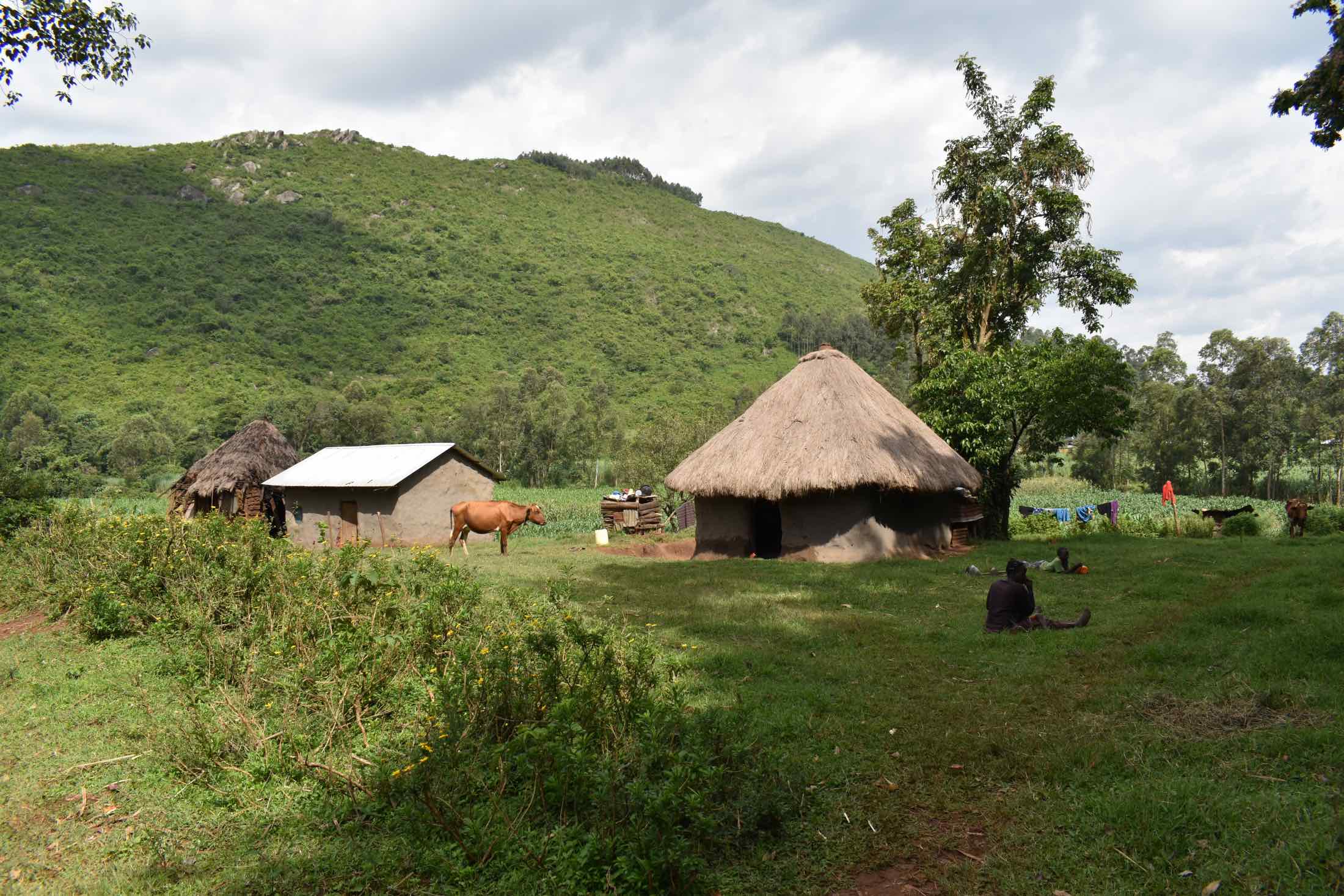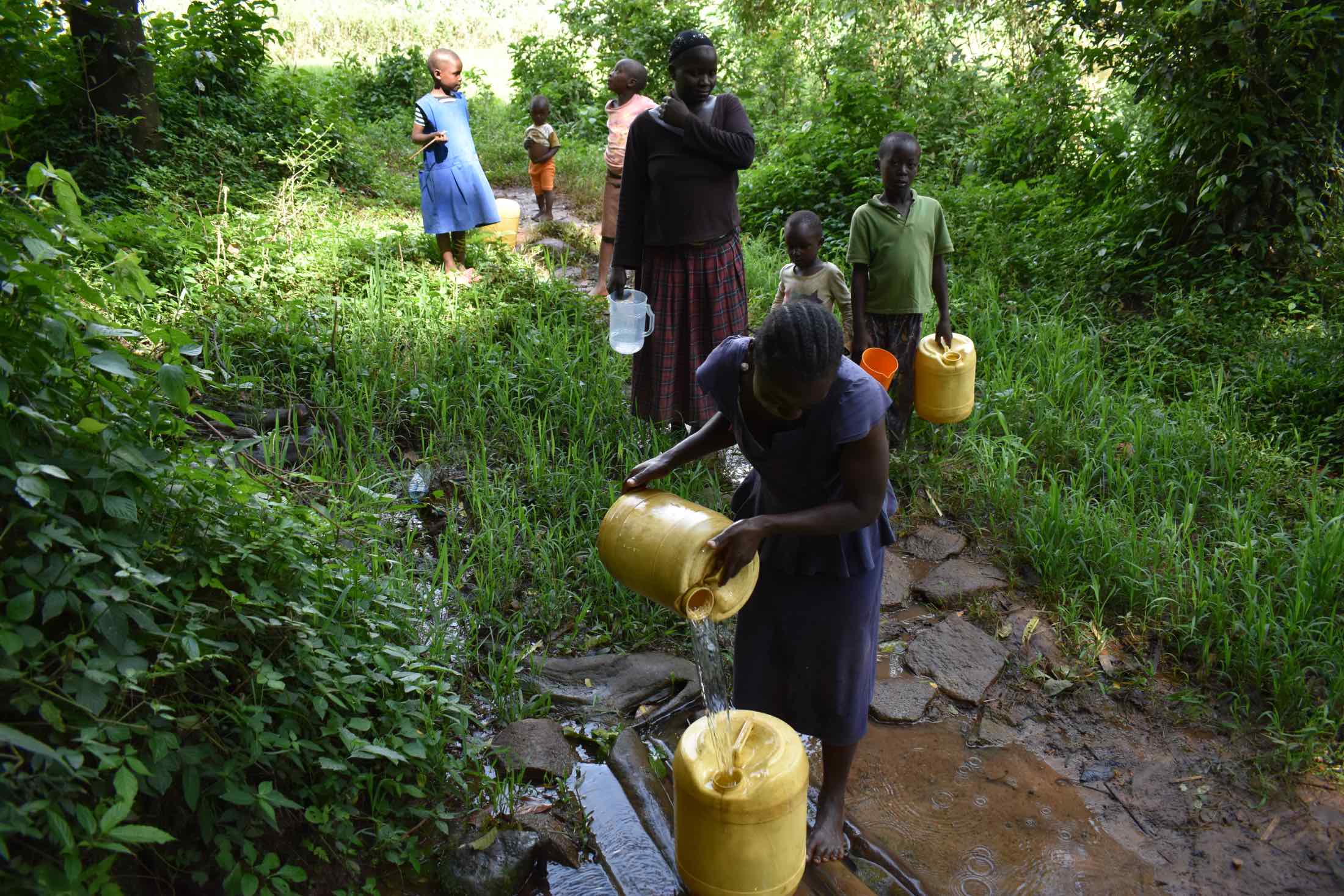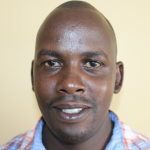Mungakha Spring is found at the edge of the Kisere Forest Reserve, which has many indigenous trees that make the area green and lush. Roads leading there are weathered and impassable during the rainy season.
Residential homes in this area vary: temporary houses made with mud walls and grass-thatched roofs, semi-permanent ones made of mud walls and roofed with iron sheets, and a few permanent ones made of either bricks or stone walls and roofed with iron sheets.

This community has ventured most into agricultural activities for their livelihood. Community members are peasant farmers who grow different small-scale crops mainly for consumption, but surpluses are taken to the market to sell or exchange for other goods.
The water source that serves this community of 150 people is open to all agents of contamination. Since the spring is found at the forest's edge, animals like monkeys contaminate the water source, and leaves and fruit fall from nearby trees landing in the water to rot. The contaminated water makes people sick with headaches, sore throats, and coughing. Illness means children miss school and fall behind academically—adults who are ill and unable to do farming activities lose their family's livelihood and food sources.

Judith Mwachi, a 30-year-old farmer and mother, explained, "Though [I] personally don't have any challenge relating to health by use of [the] water drawn from this spring, the same challenge has affected me in one way or the other. I spend a lot of my resources treating my kids for waterborne diseases as a result of using [the] same water fetched from this spring."
It is also difficult to access the water point, especially during the rainy season, because parts of the path are steep. The route becomes waterlogged and slippery. While wearing sandals, one has to remove them or step into the muddy area to draw water.
"I do waste a lot of my time fetching water from the water source because I must be careful so as not to fetch water with solid particles or floating leaves on the water surface. Besides that, carrying water to my home is so tiresome and hectic," shared 12-year-old Pharel K.
What We Can Do:
Spring Protection
Protecting the spring will help provide access to cleaner and safer water and reduce the time people have to spend to fetch it. Construction will keep surface runoff and other contaminants out of the water. With the community’s high involvement in the process, there should be a good sense of responsibility and ownership for the new clean water source.
Fetching water is a task predominantly carried out by women and young girls. Protecting the spring and offering training and support will, therefore, help empower the female members of the community by freeing up more of their time and energy to engage and invest in income-generating activities and their education.
Training on Health, Hygiene, COVID-19, and More
To hold trainings during the pandemic, we work closely with both community leaders and the local government to approve small groups to attend training. We ask community leaders to invite a select yet representative group of people to attend training who will then act as ambassadors to the rest of the community to share what they learn. We also communicate our expectations of physical distancing and wearing masks for all who choose to attend.
The training will focus on improved hygiene, health, and sanitation habits in this community. We will also have a dedicated session on COVID-19 symptoms, transmission routes, and prevention best practices.
With the community’s input, we will identify key leverage points where they can alter their practices at the personal, household, and community levels to affect change. This training will help to ensure participants have the knowledge they need about healthy practices and their importance to make the most of their water point as soon as water is flowing.
Our team of facilitators will use a variety of methods to train community members. Some of these methods include participatory hygiene and sanitation transformation, asset-based community development, group discussions, handouts, and demonstrations at the spring.
One of the most important issues we plan to cover is the handling, storage, and treatment of water. Having a clean water source will be extremely helpful, but it is useless if water gets contaminated by the time it is consumed. We and the community strongly believe that all of these components will work together to improve living standards here, which will help to unlock the potential for these community members to live better, healthier lives.
We will then conduct a small series of follow-up trainings before transitioning to our regularly scheduled support visits throughout the year.
Training will result in the formation of a water user committee, elected by their peers, that will oversee the operations and maintenance of the spring. The committee will enforce proper behavior around the spring and delegate tasks that will help preserve the site, such as building a fence and digging proper drainage channels. The fence will keep out destructive animals and unwanted waste, and the drainage will keep the area’s mosquito population at a minimum.

 Protected Spring
Protected Spring
 Rehabilitation Project
Rehabilitation Project
























 "The training impacted me positively as I was able to learn soap-making, which I have never learned of before," said our friend Erel. "I will be able to teach my fellow friends at school and the community at large, which will help us all to improve hygiene and sanitation in both schools and at home."
"The training impacted me positively as I was able to learn soap-making, which I have never learned of before," said our friend Erel. "I will be able to teach my fellow friends at school and the community at large, which will help us all to improve hygiene and sanitation in both schools and at home."










